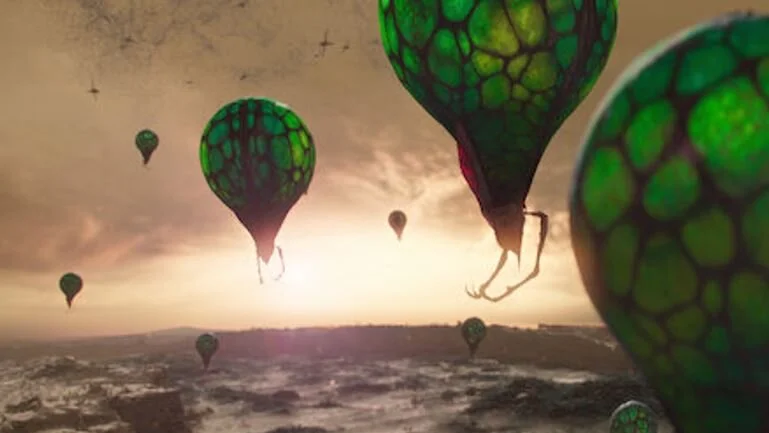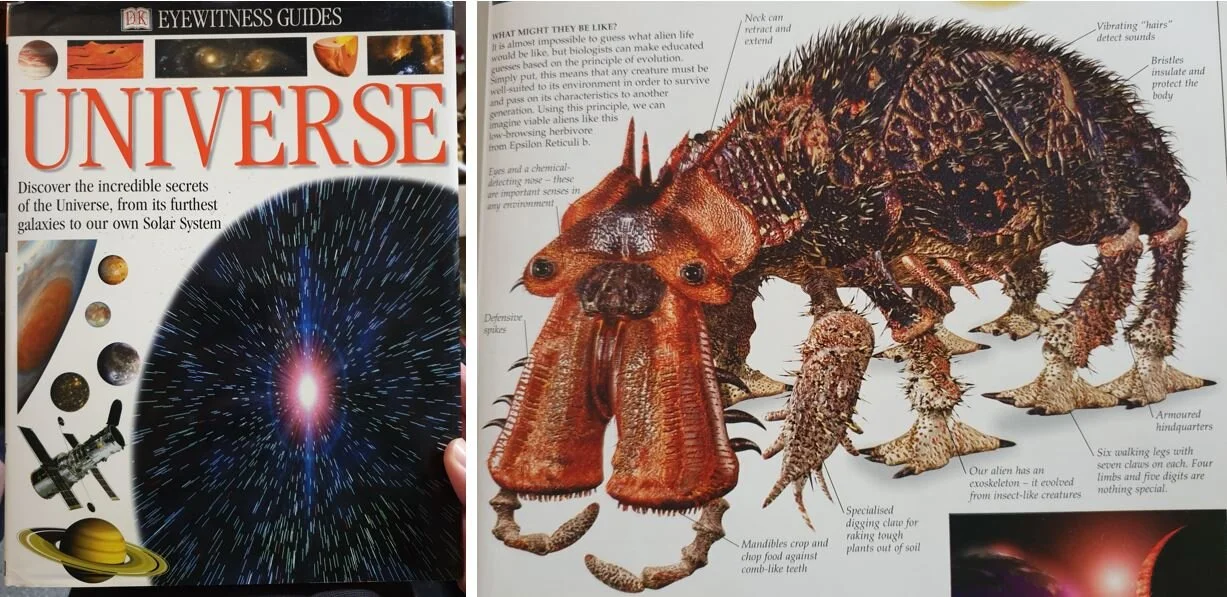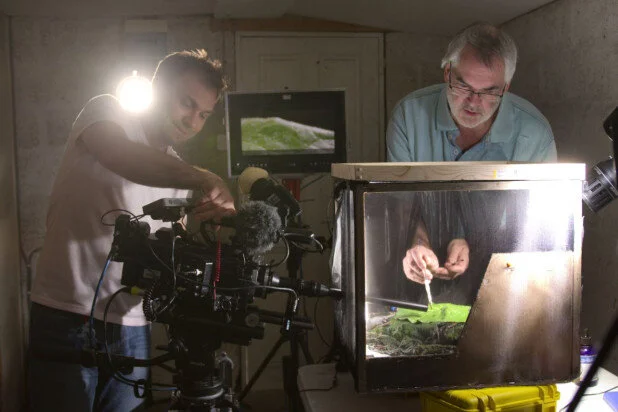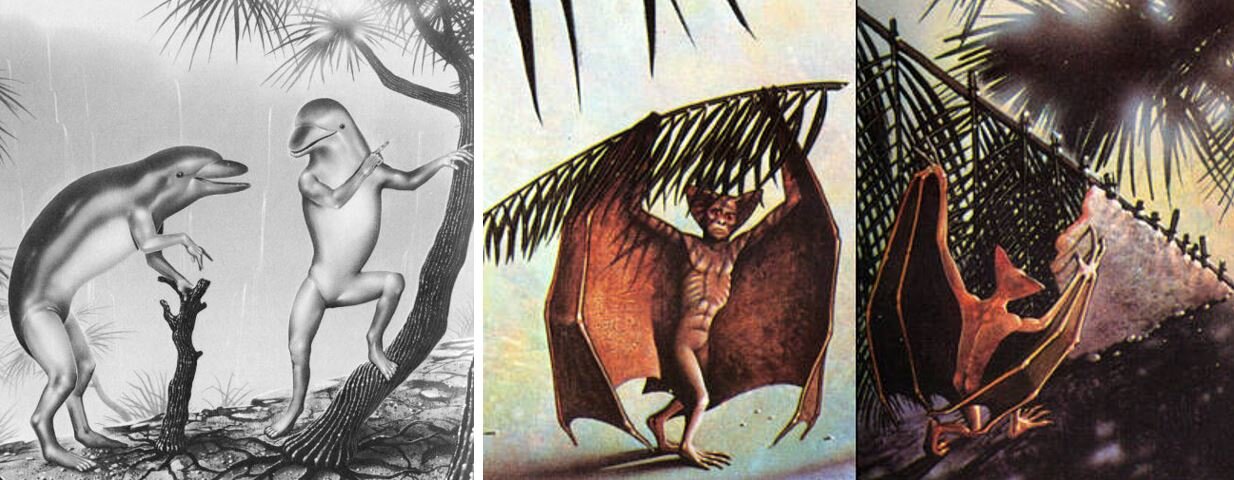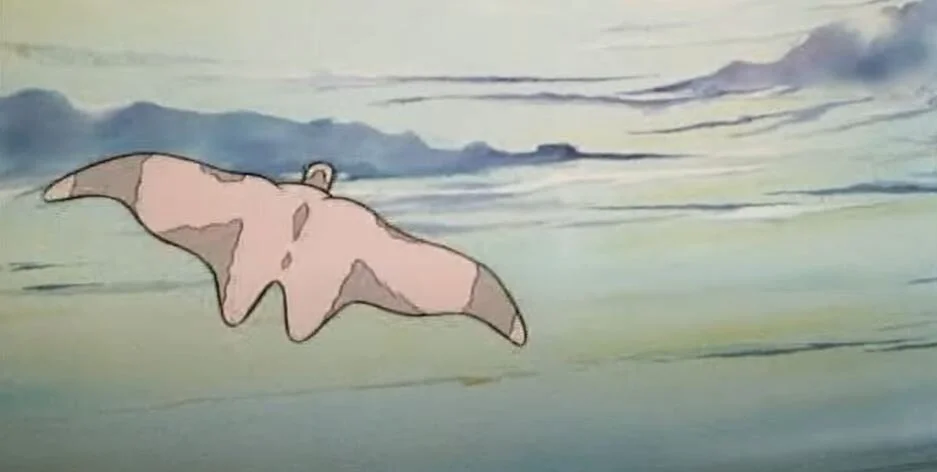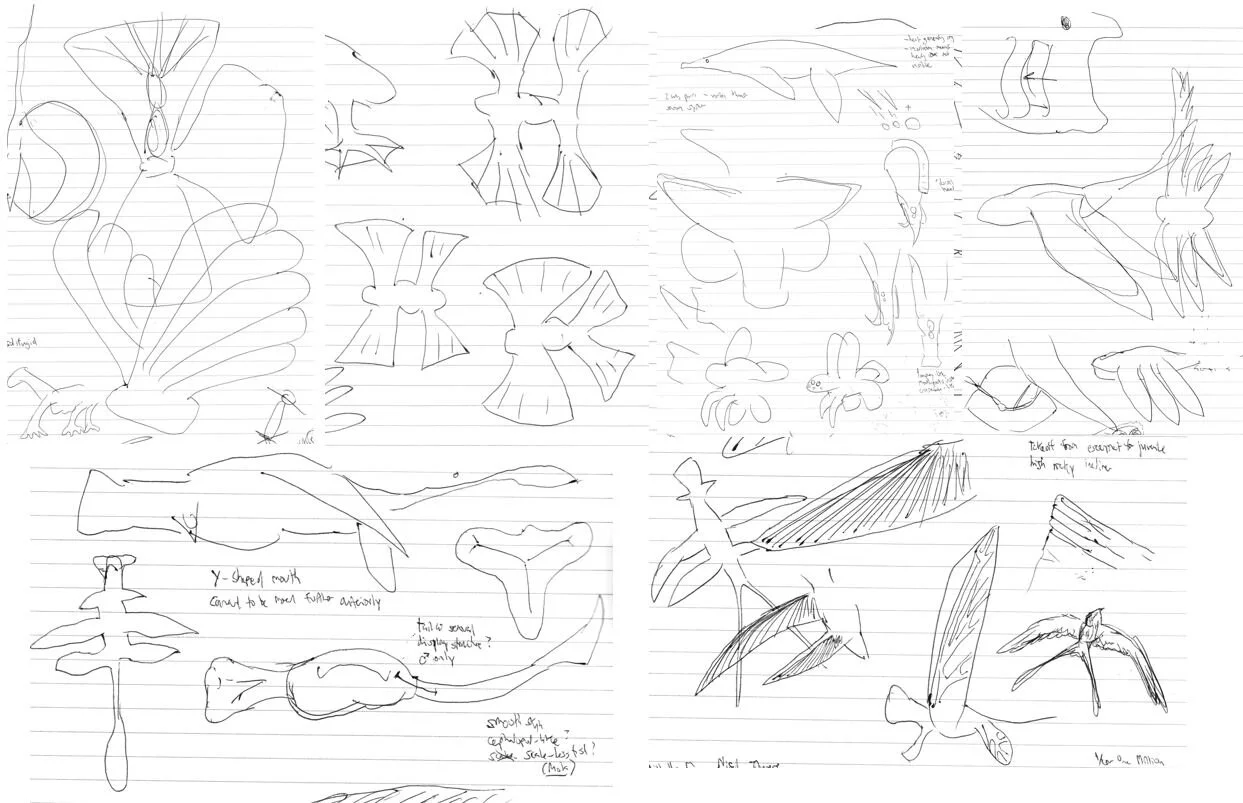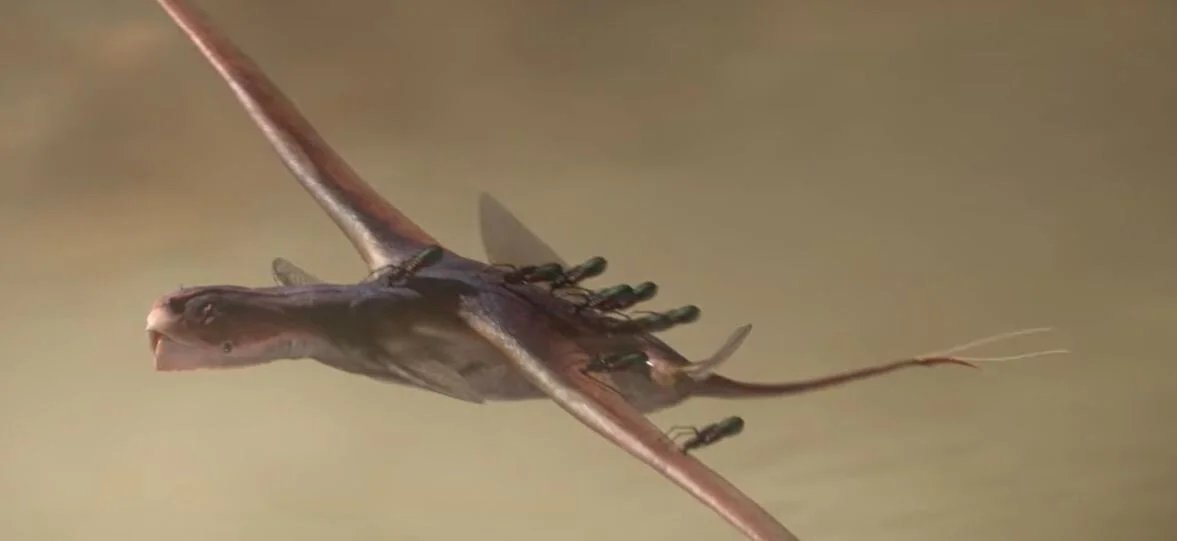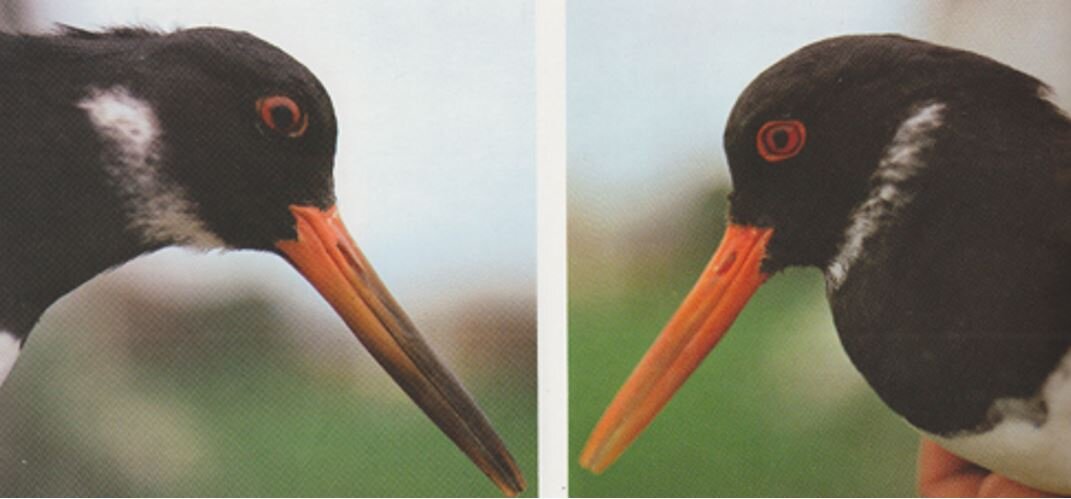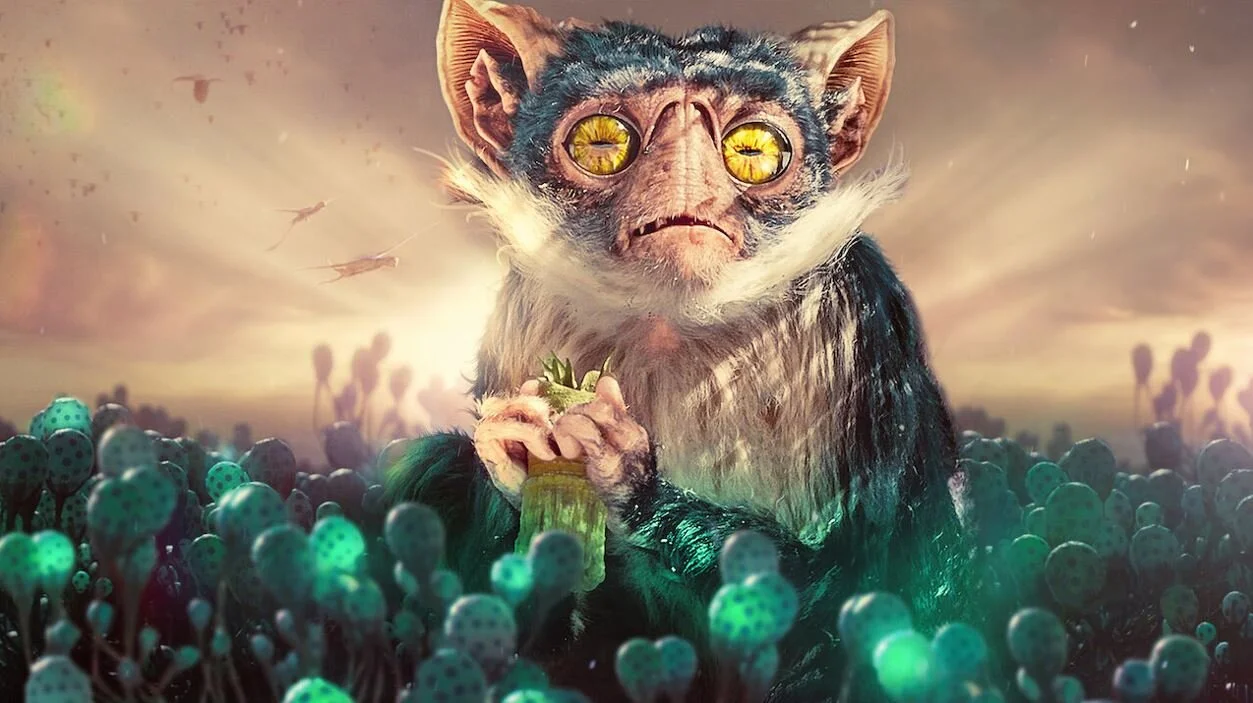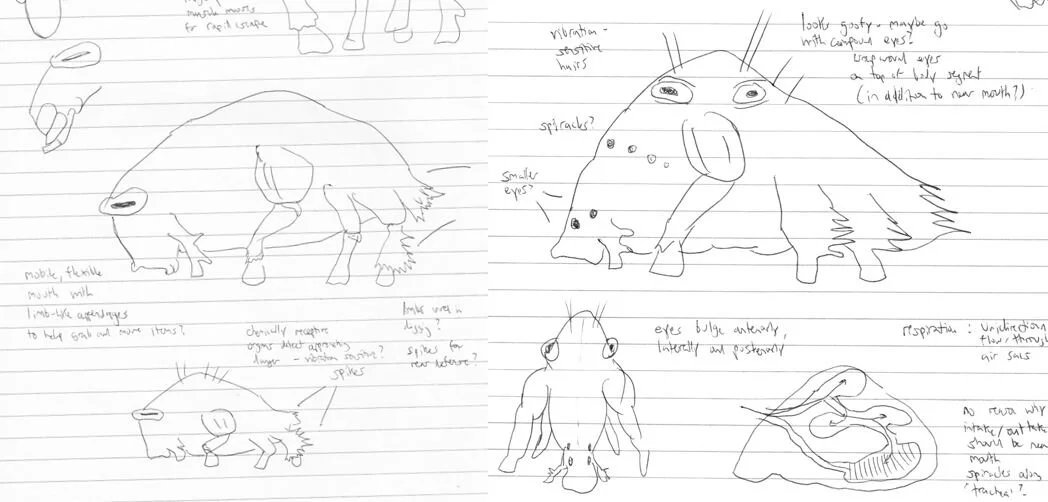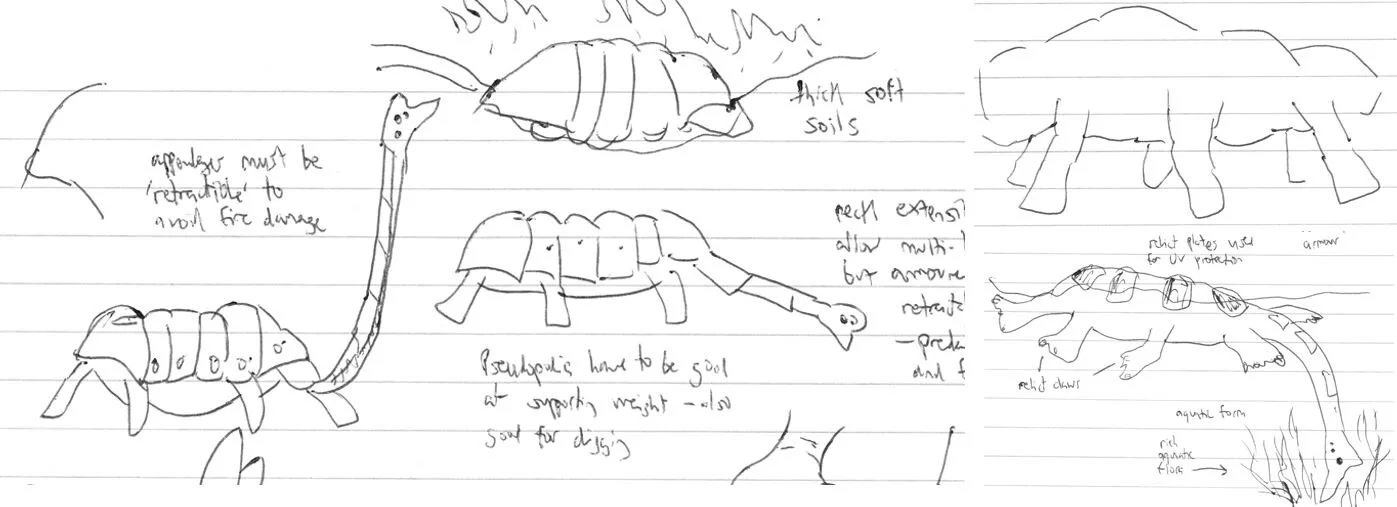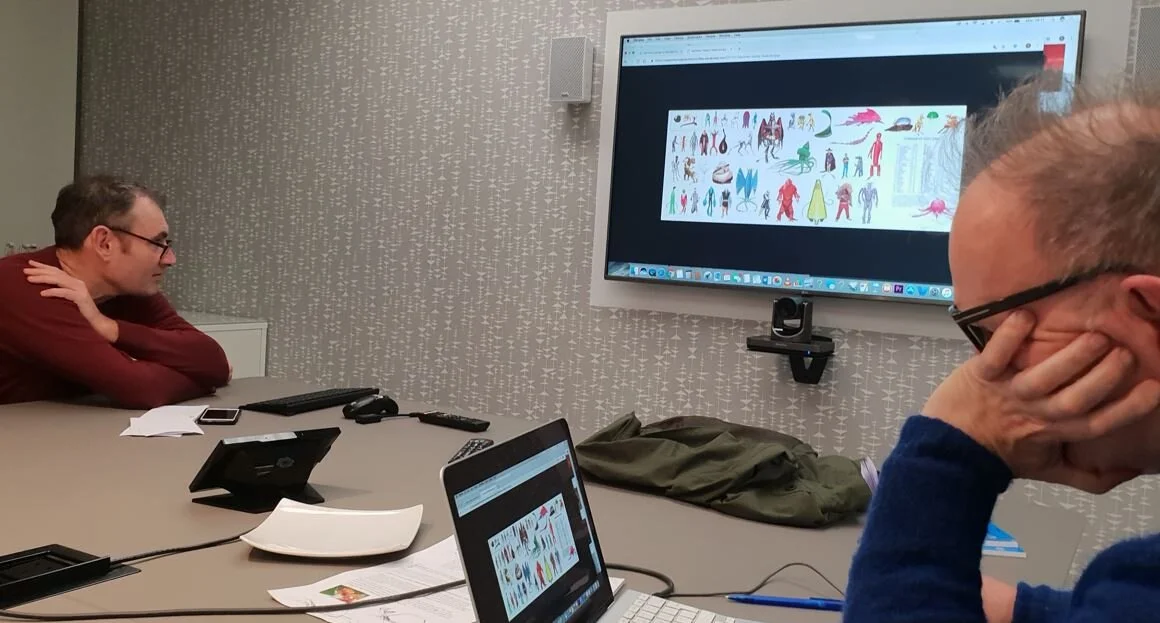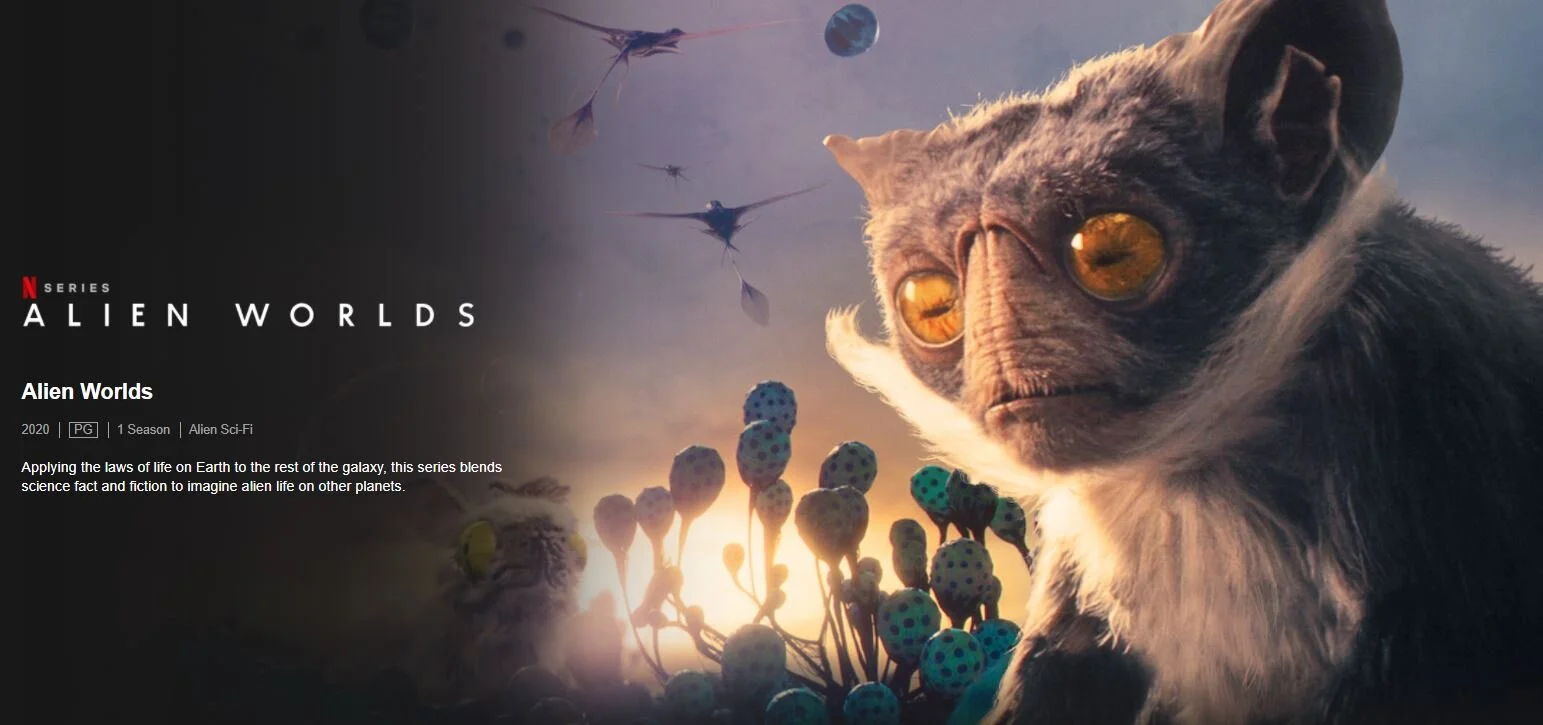December 2020 saw the release of the Netflix series Alien Worlds, a four-part exploration of imaginary alien life. The series is science-led throughout and incorporates world-class CG creature effects in addition to real world explorations of the various biological and evolutionary phenomena discussed across the episodes. Sophie Okonedo narrates.
I’m writing about Alien Worlds because I was one of the series’ several scientific consultants and was involved in designing and bringing to life its several creatures. Pretty much a dream job, right? Yes, during late 2018 and the first few months of 2019 I worked with Nigel Paterson and Tim Lambert of Wall to Wall Media, Paul Simpson of Framestore and others in the development of this series, known at the time as First Contact. Our aliens were designed to be interesting and, arguably, plausible inhabitants of a suite of distinct alien worlds.
As you’ll know if you’ve watched Alien Worlds already, each episode revolves around the hypothetical life of a given alien planet. The planets differ in their parameters: in size, proximity to their nearest star, gravitational regime, in rate of rotation and so on. I wasn’t involved in any of these aspects of planetary design; they were all established – thanks predominantly to the work of astrophysicist René Heller – earlier in the project.
Caption: balloon-like predators of the planet Atlas. Read on for something of their backstory. Image: (c) Netflix.
The Rules. Alien Worlds sets out as its premise the fact that there are a vast number of potentially habitable worlds in the universe: millions of them, in fact. We’re then introduced to a series of planets which differ in size, gravity, atmosphere and so on, and we then consider what sort of animal-like organisms might evolve on those planets. The ideas are science-based, for sure, but – there’s no pretending otherwise – they absolutely and entirely are speculative guesses, and the creatures we devised are no more probable than a million or more other, alternative possibilities.
Our visions of what might be possible when it comes to the form and biology of alien organisms are based on the rules or guidelines of physics, chemistry and natural selection. The look, biology and ecology of alien organisms are of course inspired by the organisms of Earth. Adaptation to, say, a life on land or in the air or water, to a diet of plants or animal prey, to different climatic conditions, to seasonality and drought, and so on, are all factors we need to keep in mind as things that would influence alien evolution. Furthermore, the involvement of such phenomena as sexual selection, convergence, co-evolution, symbiosis, parasitism, gigantism, dwarfism, dispersal, predator avoidance, competition, polymorphism, hybridisation and so on are further factors we might focus on when seeking to explore the possible evolutionary trajectories available to alien life. The possibilities are so many. If anything, they’re too many.
In view of that, it might be most fruitful to imagine that a TV series devoted to imaginary alien life simply has to work around two major rules.
Caption: many of us who write about, or study, animals get asked to design imaginary aliens at one point or another. My biases mean that my aliens always look like vertebrates or arthropods.. in other words, they become charismatic megafauna. Here’s one I helped design for Robin Kerrod’s 2003 Dorling Kindersley book Universe.
Rule 1 is that you have to end up with a product that’s entertaining to the public at large. Those of us interested in science – especially in the deep, hard, heavy, complex stuff – might not like it, but it’s a fact. If anyone is going to watch the series, they simply must be entertained, otherwise they’ll stop watching. This is a non-trivial factor, and it means that any ideas you might want to explore on, let’s say, chemosynthetic microorganisms living deep in the rocky interior of a planet will lose out to those on animals that look like fast-moving alien monkeys, cats, dinosaurs, or at least beetles or spiders. Alien Worlds thus very much, very understandably, focuses on big, active organisms which mostly look and behave like vertebrates or big arthropods. There’s no avoiding this. Rule 1.
Rule 2 is that you want your audience to feel (hopefully, for valid reasons) that they’re learning while they’re being entertained. And we’re not making Reality TV here; this is a science-based series, so you have to actually go to genuine trouble to include science, and scientific thinking and principles, where you can. A series about imaginary animals will tell us stories about its animals, but these stories will be designed to tell or show us something sciencey. And because the best way to explain those sciencey ideas to your audience involves hearing about them from the narrator and from actual scientists, the educational mandate of the series requires that you’re going to get a fair amount of explanatory prose and footage.
Caption: numerous segments of Alien Worlds focused on living animals and their biology and evolution. A sequence on sexual combat in beetles focused on the adventures of a film-maker who films rhinoceros beetles. Image: (c) Netflix.
The biggest and most persistent complaint about Alien Worlds I’ve seen is that it simply included too much of this Rule 2 content. I wasn’t involved in any part of this side of the series and am inclined to agree, but I can also see that it would have been prudent to include this content given that CG (of the quality we produced) is incredibly expensive and budgets are always limited. More on the structure of the series later.
Life on Atlas. The series starts with life on the high-G world Atlas. It orbits a binary star system and is tectonically active. How organisms have adapted to deal with gravity is a non-trivial issue, and surely this is the place to cover it (Rule 2), so we opted to explore several possibilities. One is that animal-type creatures might be low, squat, close to the ground, and possess a body shape and form of locomotion that doesn’t involve much resistance to gravity. During development we did specifically discuss the squat, chunky quadrupeds of Bylinsky’s Life in Darwin’s Universe (Bylinsky 1981). The result is the ugly, blob-like ‘scavengers’ (I’m not a fan of that name, especially as we see them engaging in active predation!). I wasn’t involved in their design but was happy with their concept.
Caption: having mentioned Gene Bylinsky’s 1981 Life in Darwin’s Universe, I have to share a few of its illustrations because they’re…. interesting! They’re by Wayne McLoughlin. Images: Bylinsky (1981).
The main characters of the Atlas episode, however, are the giant sky mantas, termed ‘sky grazers’ in the final product. Why posit the existence of gargantuan gliders on a high-G planet where animals would, surely, want to remain ground-huggers as much as possible? As discussed in the episode, high-G conditions lead to dense atmospheres, potentially full of particulates, and to the theoretical existence of an ‘aerial plankton’ if there are living things releasing spores or whatever into the air. On that note, I’m not going to talk about the alien plants of Alien Worlds – I’m no botanist, and this is Tetrapod Zoology anyway – but I do want to say that a lot of good work went into the xenobotany of the series, I believe much of it thanks to Lewis Dartnell. Lewis has written a lot about the potentials for alien life and especially about plants (or plant-like organisms, anyway).
Anyway, the idea of an ‘aerial plankton’ immediately led to speculations about aerial planktivores, and when I joined the project in late 2018 there were already plans to develop a ‘sky manta’ beast. Such creatures have, of course, been done before… I think immediately of the creatures of the 1983 animated film Skywhales.
Caption: the manta-like flying animal of the animated movie Skywhales. This film was shown in cinemas, where it accompanied the movie 1984.
But, yes, why go this way in our speculation? Another possibility for adaptation to life in high-G is that organisms might use skeletons, high power to weight ratios, efficient respiration and high metabolic output to counter gravity. We know that real-world animals raised in high-G develop stronger bones, bigger muscles, larger hearts and so on to counter gravitation effects, so it isn’t silly to posit the evolution of ‘high-powered’ beings on a high-G world, assuming that there’s the available energy, biochemistry, evolutionary potential and so on.
Caption: ground-bound, baby Sky Grazers have to get into the air before predatory, blob-like Scavengers smother and consume them. Credit: (c) Netflix.
After toying with various wing configurations and body shapes for our creature, we ended up with something vaguely manta-shaped, one constraint being that we needed to have the babies as terrestrial and with wings that were (initially) not intended to be fully extended all the time. Yes, we could devise a lifecycle whereby babies were birthed in the air or something, but we needed (for story reasons) to have some predatory interaction with terrestrial organisms, namely the blob-creatures. And we wanted (again, Rule 1) to show the babies taking flight in order to keep things perilous and exciting. The idea that flight-capable creatures might not be optimally designed but encumbered by handicaps which display their good genes – inspired by the tails of swallows and peacocks (and, yes, we looked at Microraptor too) – resulted in sexual dimorphism and a sequence on mating displays (Rule 2!).
Caption: concept and development sketches pertaining to the Sky Grazers, from my notebook. Images: Darren Naish.
If there are large animals, there might well be predators or parasites of them, and here we come to another way in which organisms might deal with high-G. Namely, the incorporation of flotation devices. Already in the world of speculative aliens there’s been some discussion of whether ‘balloon animals’ would really work. Over at the excellent Furahan Biology blog, Gert van Dijk has shown that imaginary balloon animals (he terms them ballonts) can’t work on Earth, since the mass of the organism outweighs its potential lift, at least so long as the animal is small.
This all changes if gravity and atmospheric density is different from that of Earth, though. On a high-G planet with a dense atmosphere, the lifting capacity of a light gas like hydrogen is different: I’ve been unable to find the calculations that were performed while we devised our buoyancy creature (generally just termed ‘predator’), but things work out so long as the animal has a light gas store of sufficient volume.
Caption: a Sky grazer is attacked by a fleet of gas-bag predators. Image: (c) Netflix.
Our buoyancy animals went through lots of rounds of revision as we came up with various ideas on their directional fins and ridges (all of which would affect their ability to manoeuvre themselves), on the shapes of their appendages and mouths (since we wanted them to grasp onto, and ultimately bite, sky mantas), on their colours and camouflage, and on their sensory abilities and their look of their eyes. Nigel corresponded extensively with Nicholas Roberts, Professor of Sensory Ecology at the University of Bristol, on this issue.
Caption: the multi-limbed, multi-eyed creatures of Janus are shown predating on smaller, arthropod-like, swarming creatures. Image: (c) Netflix.
World of The Things that are arthropod-like. Next, we come to our tidally locked planet Janus, a volcanically active body, smaller than Earth, orbiting a red dwarf, and with a fairly barren, dry vista dominated by deltas of glacial outwash. The tidally locked nature of this planet (its rotation period is equal to its orbital period, thanks Susan for the correction on this [see comments]) mean that one side is permanently bright and warm, and the opposite is cold and dark. What might this mean for creatures that inhabit the thin, twilight strip where both regions meet?
We initially saw this world as an excuse to explore some possibilities for diversification within a given group of closely related species – arthropod-like animals called The Things – before settling on the idea of focusing on polymorphism, this being the phenomenon whereby members of a species can take on a very different look and even lifestyle according to their ecological circumstances. Polymorphism in large, complex organisms can involve such things as variation in pigmentation, but also such fundamental things as the shape of the feeding and foraging organs (like bill length and shape in birds), and overall form, proportions, and the length of appendages (as in tadpoles, lake-dwelling fishes and certain lizards) (Skúlason & Smith 1995).
Caption: one of my favourite examples of polymorphism in a vertebrate…. though it’s pretty subtle compared to that seen in some other organisms… bill shape variation in oystercatchers. Some individuals have slim, pointy, knife-like bills, others have stout, blunted, hammer-like bills. Image: Hosking & Hale (1983).
The Things had quite the interesting development arc which extended over such a long time that I’ve forgotten much of it. We always planned to have The Things be arthropod-like, and – as you can see from my notebook sketches here – they started out as amblypygid-like arachnoid-type creatures. After all, arthropods are such a vast success story, clearly embodying a design so effective that it could well emerge on other planets. The problem is that our Things ended up looking essentially the same as real world arthropods (at least, to non-specialist eyes). We needed something different, and at one point – I forget the inspiration but remember the meeting – we came up with a new design, a sort of animated wastebin animal ringed with scallop-like eyes, possessing pentameral symmetry and with an echinoid-like oral aperture on its apex.
Caption: sketches depicting the development of our multi-limbed, vaguely arthropod-like aliens of Janus. Images: Darren Naish.
Planet-building work had already established that such a world would possess high winds (something which guided the look of the planet’s vegetation, incidentally) so we also developed the idea that the Things might use (but not necessarily rely entirely on) wind dispersal for the distribution of their eggs, larvae or babies. I came up with the idea of spiny, winged babies that could be pushed far and wide by winds, a concept that ended with the winged larvae you see in the final episode.
Needless to say, the idea of highly mobile, dispersive youngsters, operating partly at the whim of local conditions and destined to make landfall in an environment potentially very different from that of their parents goes hand-in-hand with our concept of polymorphism in these animals. The Thing you grow up to be depends on where you landed as a baby.
Caption: one of the planets explored in the series - Eden - is home to animals that look suspiciously mammal-like. But look below; we started from a very different position. Image: (c) Netflix.
The Tangled Bank… in space. Another episode concerns life on the super habitable world Eden that has high oxygen and CO2, is closer to its star than Earth is (and rotates faster, and has shorter seasons), and is formed of numerous small continental plates and has many islands. What stories might you explore on a high-energy planet with complex ecosystems? There might be numerous tight examples of co-evolution (presuming that there’s been enough time for such things to evolve), an unusually high percentage of animals might be highly specialised, and fire could be a perpetual risk, this resulting in the evolution of fire-avoidance features.
This episode has received the most amount of criticism since its creatures – the predatory climbing animal in particular – look quite mammalian, and specifically primate-like. I’m not going to take any blame for this, since much of what happened here occurred after my involvement ended. I helped devise a primary consumer – an animal playfully dubbed Space Rabbit – which was essentially a froghopper-like, rabbit-sized, mound-shaped creature with a ventrally located mouth, dorsally sited eyes and spring-loaded limbs.
Caption: space rabbits! Nothing like this made it into the final series; instead, we have the rabbit-lepidopteran hybrid that is ‘The Grazer’!
We did initially go a very different route, though. The need to devise herbivores able to exploit abundant, seasonally available vegetation led to my invention of a group of pseudopod-bearing megaherbivores with extensible necks. Such animals wouldn’t be fast enough to escape the sort of rapid-burn fires that would regularly sweep through their habitat during parts of the year, so they had a light, flexible, jointed armour carapace that would – combined with swift burrowing into their habitat’s deep and soft soil – afford sufficient protection. A much-modified form of this fire avoidance strategy made it into the final episode and explains why the ‘grazers’ produce shell-like reproductive cocoons which undergo development while suspended from trees some distance off the ground.
Caption: a group of Eden megaherbivores that were not to be. Fire-resistant, stretchy-necked browsers able to burrow and retract their appendages when required. An aquatic lineage were imagined as well.
If our megaherbivores are big, well armoured and able to dig, I imagined a quadrupedal predator that was able to find and feed on them. It could fly and leap into flight (its highly foldable wings could be stowed and concealed during its terrestrial forays in the forests). An additional pair of foldable limbs were raptorial in function but also useful in digging. This predator – it’s labelled Baby Eater in my notes – looked more like a giant, horizontal-bodied mantid than a six-limbed monkey. It gave way to a less arthropod-like predator adapted for climbing, equipped with binocular vision, grasping hands and feet and (again) rapid-strike, raptorial, foldable limbs that are ordinarily stowed away and concealed on the animal’s underside. I didn’t want this animal (it’s ‘Space Monkey’ in my notes) to look vertebrate-like, but that’s the direction it ended up taking…. and it’s possible that it was involved in the ‘ancestry’ of the predator that starred as one of the main characters in the final episode. All of these animals, by the way, were spiracular breathers, because why not.
Caption: prototype versions of Eden’s predators, creatures which were loosely ‘ancestral’ to the Space monkey that appeared in the final episode. Images: Darren Naish.
Again, if we imagine what the theme was (Rule 2), it was to depict the existence of complex lifecycles, symbiosis, co-evolution and a tangled food-web. There’s only so much you can do given the limits of time, budget and audience interest, so we couldn’t go wild and talk about an organism with a seven-step, complex, situationally dependent life cycle (the sort of thing that exists here on Earth, among multiple lineages).
Instead, what you get is pretty simple, but complex enough to send the message (as per Rule 2): there’s a predator-prey relationship between two species, but the behaviour of the prey species can be modified by a parasite… which is passed to the predator when it consumes an infected prey animal, the result being behavioural modification of the predator too and the start of a new cycle for the parasite. The fairly terrifying parasitic fungus Cordyceps was an obvious inspiration here, as were other parasites that modify the behaviour of their hosts.
And finally… I had no involvement at all in the last episode, which is all about a technologically advanced species which persists as a sort of hive-mind entity which have reduced their physical biology to neural tissue alone.
It should be obvious from this article that the discussions, decisions and consultations which form the background to the worlds, environments, habitats and creatures of Alien Worlds were extensive. Nothing was simply invented and then deemed ready as a final product. On the contrary, we went through weeks of discussion, repeatedly honed and modified designs, and sought advice, opinion and even scientific testing of the creatures and our ideas about them.
Caption: proof that we were very much aware of previous alien concepts. The aliens covered in Barlowe’s Guide to Extraterrestrials are visible on screen; Nigel at left, Tim at right. Image: Darren Naish.
It’s therefore very right, I feel, to be a bit distressed or upset that none of this made it into the final broadcast. I would have loved it if it did, since it was just about the most interesting part of the project. But I’m not in charge, and this ‘behind the scenes’ or ‘making of’ aspect wasn’t seen as part of what actually made it to our screens: it was regarded as boilerplate, ‘under the hood’ stuff, not in keeping with Rules 1 and 2. Studio executives and so on make the decisions about what audiences want, and surveys and studies show – so we’re repeatedly told – that they don’t want nerdy stuff about creature design. As a reader of this blog, you are not an average audience member of a TV series like this.
On that note, Alien Worlds has proved successful. As we all know, Netflix closely guards its data on audience shares and so on, but we do know that Alien Worlds was in the top 10 most-watched TV shows across part of December at least, and I see that it’s still available and still being watched as of this week. It was certainly a fun project to be involved in, my thanks and admiration to everyone I worked with.
Will there be more speculative, world-building exercises of this sort? I can’t say, but I know that there are plans.
For previous TetZoo articles on Speculative Biology and related issues, see…
The Dougal Dixon After Man Event of September 2018, September 2018
On May the 4th, Some Star Wars Musings, May 2019
Alternative Timeline Dinosaurs, the View From 2019 (Part 1), December 2019
Alternative Timeline Dinosaurs, the View From 2019 (Part 2), December 2019
Alternative Timeline Dinosaurs, the View From 2019 (Part 3): the Dinosauroid and its Chums, December 2019
Refs - -
Bylinsky, G. 1981. Life in Darwin’s Universe: Evolution and the Cosmos. Doubleday & Company, Inc., New York.
Hosking, E. & Hale, W. G. 1983. Eric Hosking's Waders. Pelham Books, London.
Skúlason, S. & Smith, T. B. 1995. Resource polymorphisms in vertebrates. Trends in Ecology and Evolution 10, 366-370.


